Marisa McClellan's Blog, page 13
March 1, 2019
Herbs for the March Mastery Challenge
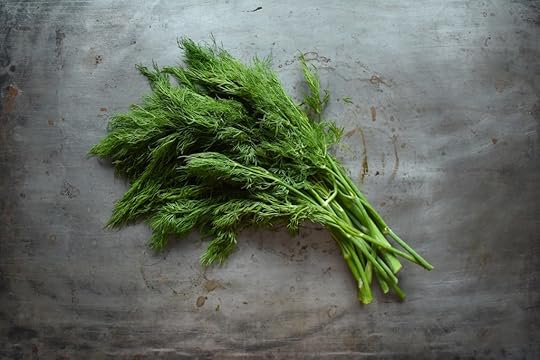
We’re at the start of a new month, which means that it’s time to wipe the Mastery Challenge slate clean and begin again with a new topic. For March 2019, our topic is herbs!
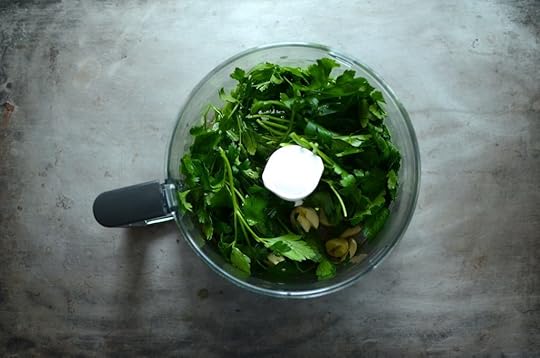
There are so many possibilities open to us this month. Here are just the ones that spring immediately to mind.
Pesto (preserve by packing into small jars, cover with a thin layer of the same oil you used to make the pesto, place lids on the jars, and freeze)Garlic herb salt Salt preserved herbs (this is what I’ll be making on my next Facebook livestream demo on Monday, March 4 at 9 pm ET/6 pm PT)Herb-infused jamHerb-spiked picklesHerbal lemonade concentrateInfused vinegarFlavored oils (for safety, make small batches and keep them in the fridge)Herbal tea blendsSavory herb rubs
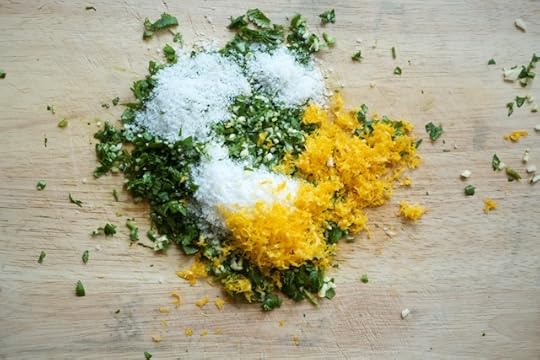
If you’re struggling to find direction for this month, I highly recommend trying a batch of hand-chopped garlic herb salt. It’s one of my favorite ways to use up fresh herb leftover from other recipes and it doesn’t require any special equipment.
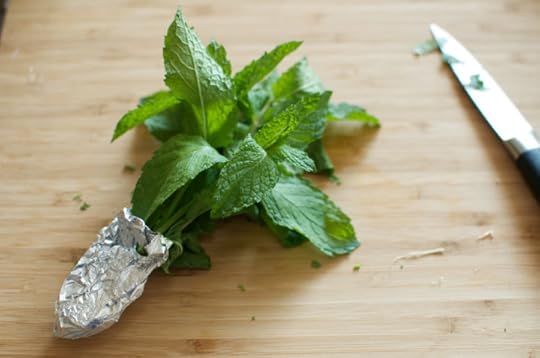
Just a reminder that this is a food preservation challenge. There are lots of lovely non-edible things that can be made with herbs, but for the purposes of this challenge, stick to things that are designed to be consumed.
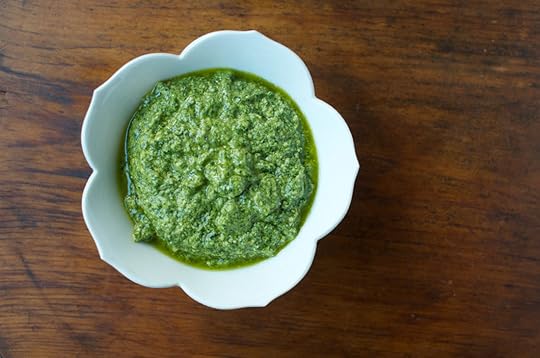
Finally, let’s recap how you participate in the Mastery Challenge. You choose a project that fits the challenge and you make it. Around the 15th of the month, I will publish a post here on the blog that will include a Google Form. You will use this to report your project (though this is not required, it ensures that I am able to include you in the monthly data).
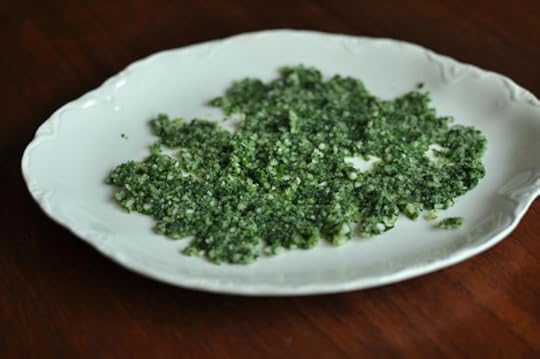
If you want to share a picture of the thing you made, post it to Instagram with the hashtag #fijchallenge. And if you have questions, join us in the FIJ Community Group over on Facebook. Most importantly, have fun.
Related Posts:February 2019 Mastery Challenge Round-upHot Dog KrautTaco Kraut
February 28, 2019
February 2019 Mastery Challenge Round-up
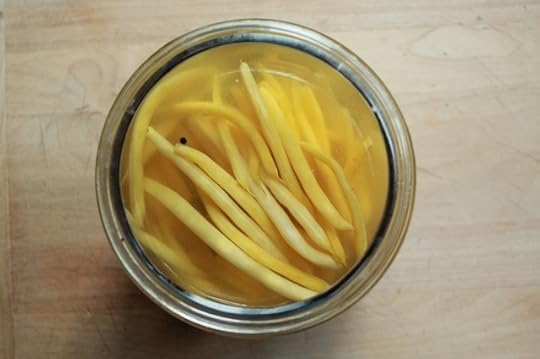
The second month of the 2019 Mastery Challenge is over, and what a month it was! This time around, 240 people reported in about more than 500 completed fermentation projects.
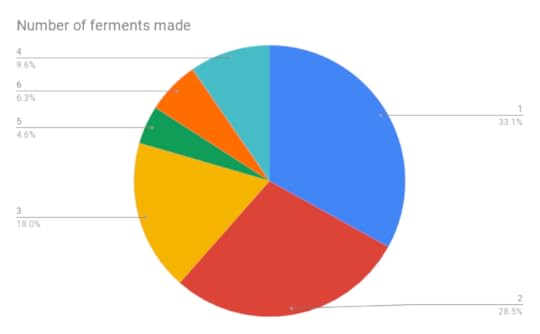
One of the cool things about having a really broad topic is that so many people make more than one thing in their excitement to really explore the possibilities. Fermentation is such a deep area that I’m really happy that so many of you didn’t settle for just a single recipe.
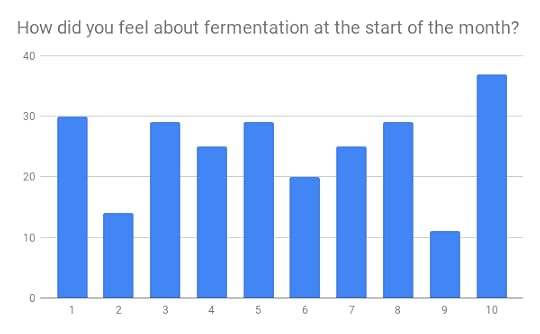
At the start of the month, feelings were very mixed about fermentation. While there were a number of folks who felt very positively about the practice, there were nearly as many who had never tried it or were unsure.
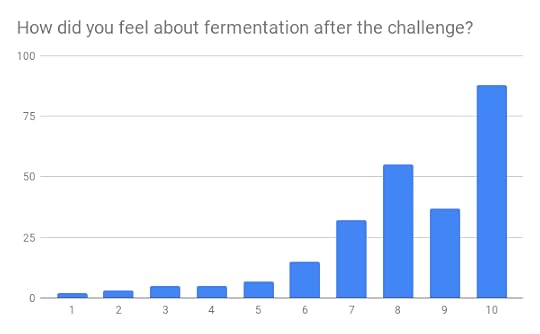
I find this second chart really satisfying. At the end of the month, the vast majority of you who participated felt really positive about fermentation. Here’s hoping that some of the recipes and techniques you guys tried this month become part of your regular food preservation practice.
View this post on InstagramA post shared by goodearthpuresoaps (@goodearthliving) on Feb 26, 2019 at 1:26pm PST
You all made so much stuff this month, but here are some of the most popular recipes. There were 110 batches of sauerkraut. More than 80 sourdough starters were created and transformed. On the yogurt front, there were 55 reported batches.
View this post on InstagramA post shared by Kendra's Kreations (@kendraskreationstexas) on Feb 21, 2019 at 6:55am PST
Kimchi clocked in at 37 batches and there were 31 of you who made kombucha. There were 20 batches of fermented garlic and the same number of brined hot sauce (though I hear that not all were as successful as desired).
View this post on Instagram
February 27, 2019
Hot Dog Kraut
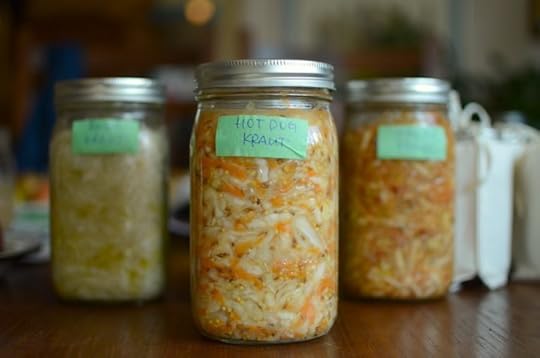
We’re nearly at the end of our fermentation month, but I want to take the opportunity to squeeze one more on-topic recipe in before the calendar changes.
This the final recipe in the series that I’ve been sharing this month (recipes for a project that got canceled after I’d done all the development and photography).
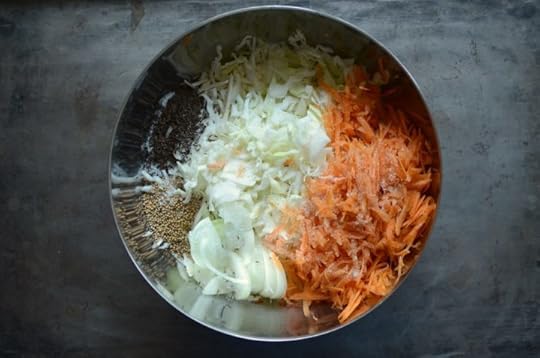
With this variation, I was trying to design something that would be great on a hot dog or sausage. Now, we already know that regular sauerkraut is good in those applications, but what if you could make it even better?
In this recipe, I add carrots for sweetness, onion for edge, caraway seeds for earthiness, and mustard seeds because to my mind hot dogs demand mustard (my husband is of the mistaken belief that one puts ketchup on hot dogs. He is wrong). The finished kraut is exactly what I was hoping for and it’s my favorite to have around during the summer cook-out season.
I hope you enjoy this final installment in my sauerkraut series!
PrintHot Dog Kraut
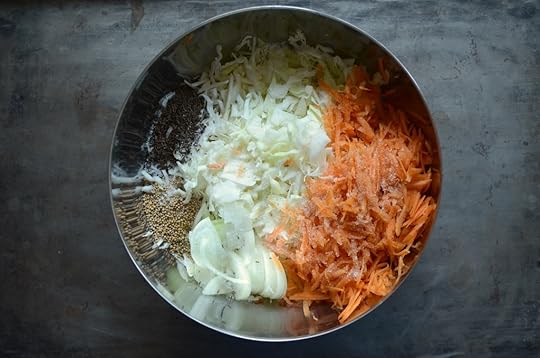
Ingredients
1 1/2 pounds cabbage, thinly sliced6 ounces carrots, grated
2 ounces yellow onion, thinly sliced
2 tablespoons yellow mustard seeds
2 tablespoons caraway seeds
1 tablespoon pickling salt
Instructions
Place cut cabbage, carrots, onion, mustard seeds, caraway seeds, and salt in large bowl.Using your hands, knead the ingredients together, squeezing firmly to help release liquid from the veg.
When the volume in the bowl appears to have reduced by half, pack the massaged veg into a wide mouth quart jar in layers, firmly pressing it down each time before adding more (the entire batch should fit into a single quart jar).
Press cabbage down firmly in the jar, so that liquid bubbles up over the surface of the jar. Loosely cap the jar (or top with an airlock, if you have one), position it on a small saucer or plate, and place it in a cool, dark spot.
Check every other day, removing any bloom and pressing cabbage down if it has floated above the liquid (be warned, it will be a bit stinky. That’s normal).
After a week, taste the sauerkraut. If you like the flavor, place the jar in the refrigerator. If you want something a bit stronger, let it continue to ferment until it pleases you.3.1https://foodinjars.com/recipe/hot-dog-kraut/
Related Posts:
Taco Kraut
Fermentation for the February Mastery Challenge
Submit Your Ferment for the February 2019 Mastery Challenge Here
February 26, 2019
Fermentation Books to Take you Further
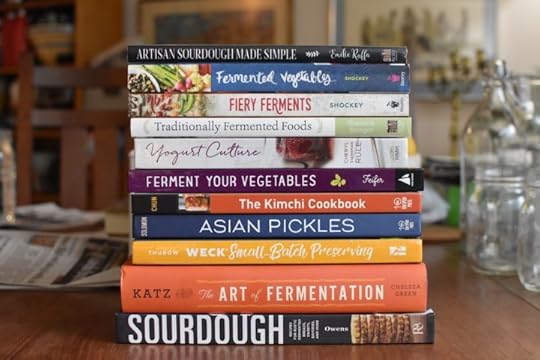
We’re getting to the end of our month focused on fermentation! I’ve heard from a number of people that they’ve really gotten into this method of food preservation and transformation.
To that end, I’ve pulled together a collection of books to help you move forward and continue to learn and explore. While this cannot be considered a complete list of great fermentation books, these are all volumes that I keep on my shelves and reference often.
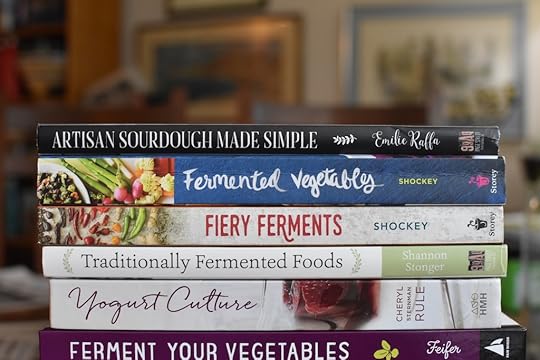
Artisan Sourdough Made Simple by Emilie Raffa – More than a few Mastery Challenge participants decided to tackle sourdough during fermentation month. I’ve seen a wide range of loaves and for those folks who are still at the start of the sourdough journey, there’s no better book than this one. Amazon | Powell’s
Fermented Vegetables by Kirsten and Christopher Shockey – This book does exactly what it says in the title. It teaches you how to ferment vegetables, with step-by-step imagery and helpful recipes. I find that I often use the information in this book as a starting place to make smaller batches of very delicious things. Amazon | Powell’s
Fiery Ferments by Kirsten and Christopher Shockey – This book is great both for basic fermentation techniques and for products that walk the spicier side of things. Amazon | Powell’s
Traditionally Fermented Foods by Shannon Stonger – This book focuses on a wide spectrum of classic fermented foods. Shannon writes the blog Nourishing Days from her family’s small Texas farm and her book feels very much like an extension of her site. It’s friendly, helpful, and comes from a place of deep experience and expertise. Amazon | Powell’s
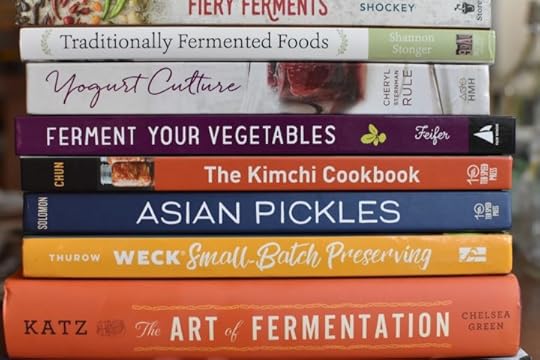
Yogurt Culture by Cheryl Sternman Rule – Cheryl spent years researching and experiencing the ways in which yogurt is made, used, and eaten all over the world, and then compiled that knowledge. If you discovered a love of homemade yogurt this month, make sure to get this book. Amazon | Powell’s
Ferment Your Vegetables by Amanda Feifer – This book focuses on vegetable ferments and includes a wide assortment of recipes for kraut, kimchi, kvass, sauces, and pickles. You’ll find small batch recipes, larger ferments made in crocks, ferments made without additional salt, and other ways to culture your veg. Amazon | Powell’s
The Kimchi Cookbook by Lauryn Chun and Olga Massov – For those of you who have fallen in love with kimchi this month, this is the book for you. There are traditional recipes as well as more modern takes. You’ll also find recipes to help you use up what you’ve made. Amazon | Powell’s
Asian Pickles by Karen Solomon – This book digs into the pickle cultures of Japan, Korea, China, India, and Southeast Asia. You’ll find ferments galore (as well as a nice assortment of quicker pickles), all featuring interesting and delicious flavors. Amazon | Powell’s
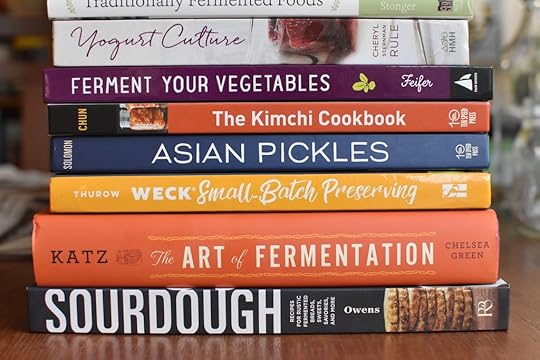
Weck Small-Batch Preserving by Stephanie Thurow – Though on the surface, this book is about preserving in Weck jars, it also contains are lots of ferments, including recipes for kvass, kimchi, and pickles. Amazon | Powell’s
The Art of Fermentation by Sandor Katz – If you only have space for one book on the topic of fermentation, this is the one to have. You could spend your entire life working through this book and you might never uncover all its wisdom. It can be dense at times, but as long as you approach it with patience, it will never let you down. Amazon | Powell’s
Sourdough by Sarah Owens – For those of you who want to take your sourdough explorations further, there’s no better guide than Sarah Owens. She’ll show you how to include whole grains, sprouted grains, and seasonal ingredients. Amazon | Powell’s
Related Posts:Cookbooks: Fiery FermentsTaco KrautSubmit Your Ferment for the February 2019 Mastery Challenge Here
February 20, 2019
Taco Kraut
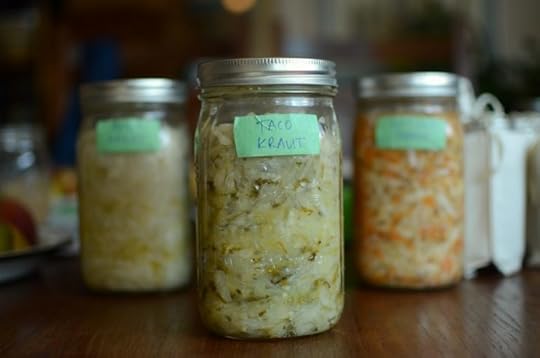
A couple of weeks ago, I shared a recipe for Kimchi Kraut that I created a couple years ago as part of a project that never saw the light of day. Today, I’m bringing you the second recipe from that series. I call it Taco Kraut.
Certainly there are more traditional accompaniments to tacos, like curtido or escabeche, but despite that, I feel like there’s space in the world for another tangy taco topping.
It starts much the same way a regular kraut starts, with a finely shredded head of cabbage. Then you add healthy portions of cilantro, scallions, garlic, jalapeno, and salt.
Because I’m something of a spice light-weight, I only use a single jalapeno. Those with hardier palates among you are welcome to use more. You could also switch to a pepper with a bit more fire. I bet habanero would delicious (if you choose to go in that direction, definitely make sure to wear disposable gloves while massaging and packing up the kraut).
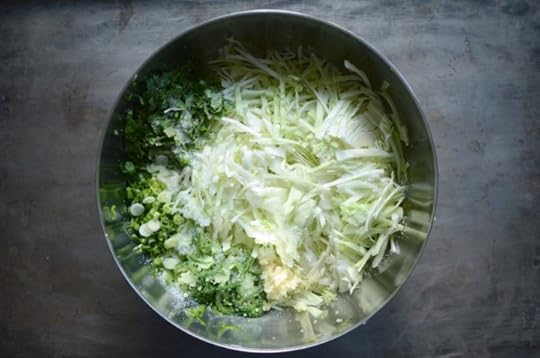
Once the ingredients are well-mixed and you can squeeze a handful of the cabbage and have a healthy stream of liquid running back into the bowl, you can pack it into a quart jar. I like to pack it in one handful at a time, pressing each layer down firmly before adding the next.
Now, I have relatively small hands and so can fit my mitts into a wide mouth quart jar without issue. If you were gifted with larger hands than I have and struggle to get your kraut tightly fitted into the jar, I highly recommend getting one of these sauerkraut tampers.
They typically run between $15 and $25 and are a boon to those who make sauerkraut regularly. I have the Pickle Packer from Masontops, but I’ve used others and they are universally handy.
In addition to the obvious use (tacos!), I like to tuck this kraut into quesadillas, fold it into warm black beans, and add it to this Cumin Cabbage Slaw (that recipe is nearly a decade old, but definitely holds up in terms of flavor and utility).
PrintTaco Kraut
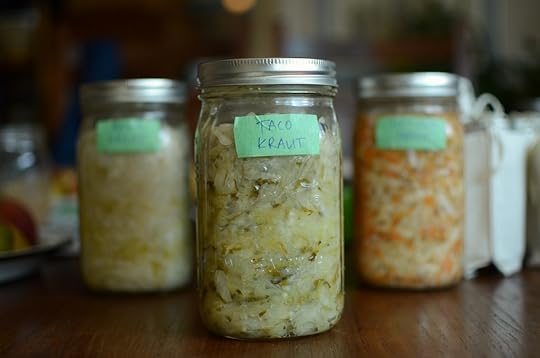
Ingredients
1 pound, 12 ounces cabbage, thinly sliced1/2 cup chopped cilantro
4 scallions, sliced
3 garlic cloves, minced or pressed
1 jalapeno, thinly sliced
1 tablespoon pickling salt
Instructions
Place cut cabbage, cilantro, scallions, garlic, jalapeno, and salt in large bowl.Using your hands (if your skin is sensitive, wear food safe gloves), knead the ingredients together, squeezing firmly to help release liquid from the veg.
When the volume in the bowl appears to have reduced by half, pack the massaged veg into a wide mouth quart jar in layers, firmly pressing it down each time before adding more (the entire batch should fit into a single quart jar).
Press cabbage down firmly in the jar, so that liquid bubbles up over the surface of the jar. Loosely cap the jar (or top with an airlock, if you have one), position it on a small saucer or plate, and place it in a cool, dark spot.
Check every other day, removing any bloom and pressing cabbage down if it has floated above the liquid (be warned, it will be a bit stinky. That’s normal).
After a week, taste the sauerkraut. If you like the flavor, place the jar in the refrigerator. If you want something a bit stronger, let it continue to ferment until it pleases you.3.1https://foodinjars.com/recipe/taco-kraut/
Related Posts:
Fermentation for the February Mastery Challenge
Submit Your Ferment for the February 2019 Mastery Challenge Here
Kimchi Kraut Recipe
February 18, 2019
Small Batch Blueberry Cara Cara Orange Jam
This small batch blueberry cara cara orange jam is a perfect solution for those of us who are itching for summer. It uses frozen blueberries and fresh winter citrus to make a zippy, colorful spread.
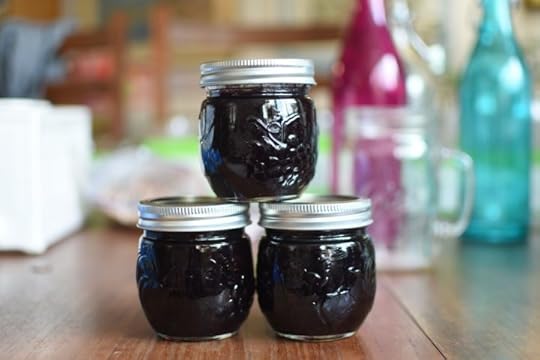
It’s fermentation month in the Mastery Challenge, but after several batches of sauerkraut and garlicky brined carrots, I’ve been itching to make a batch of jam. And so earlier today I went digging through my freezer looking for some of the fruit I squirreled away last summer. After a bit of chilly archeology, I unearthed some blueberries and decided to combine them with some Cara Cara oranges that had been in my fruit drawer for over a month.
I love tucking away little packets of summer fruit for later processing. I freeze it in small portions, just a pound or two at a time, so that it’s easy to use and can be fitted into the bare corners of the freezer. It also helps take off some of the summer canning season pressure and also allows me to make interesting combinations that aren’t always possible when I work in season.
One of my all-time favorite examples of this seasonal bending is my recipe for Sweet Cherry Rhubarb Jam. I always try to hide two pounds of chopped rhubarb in the freezer when it’s in season so that it’s ready to be combined with cherries when they arrive. The tartness of the rhubarb really brightens the flavor of the cherries.
I demoed this recipe in my FB live earlier tonight (if you missed it, watch it here). And for more of my small batch recipes, look right here.
PrintBlueberry Cara Cara Orange Jam
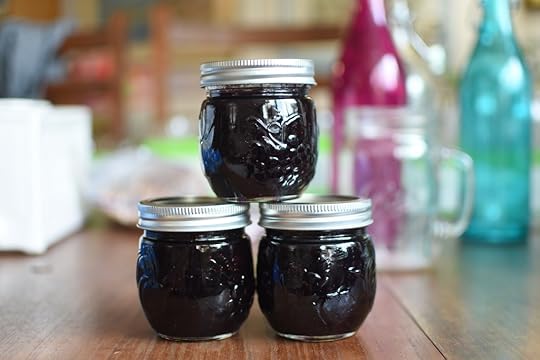
Ingredients
4 cups blueberries (frozen or fresh)4 Cara Cara oranges, segmented
2 1/2 cups granulated sugar
1/2 lemon, juiced
Instructions
Prepare a boiling water bath canner and three half pint jars.Combine the blueberries, orange segments, and sugar in a low, wide, non-reactive pan.
Bring to a boil over high heat and then reduce the heat to medium. Simmer, stirring regularly and occasionally mashing with a potato masher until thick (12-18 minutes, depending on the height of the heat and the width of your pan). Towards the end of cooking, add the lemon juice.
Funnel into the prepared jars. Wipe the rims, apply the lids and rings, and process in a boiling water bath canner for 10 minutes.
When the time is up, remove the jars and set them on a folded kitchen towel to cool. When the jars have cooled enough that you can comfortably handle them, check the seals. Sealed jars can be stored at room temperature for up to a year. Any unsealed jars should be refrigerated and used promptly.3.1https://foodinjars.com/recipe/small-batch-blueberry-cara-cara-jam/
Related Posts:
June Mastery Challenge: Foraged Berry Jam
Small Batch Strawberry Plum Jam
Vanilla Yellow Plum Jam
February 11, 2019
Submit Your Ferment for the February 2019 Mastery Challenge Here
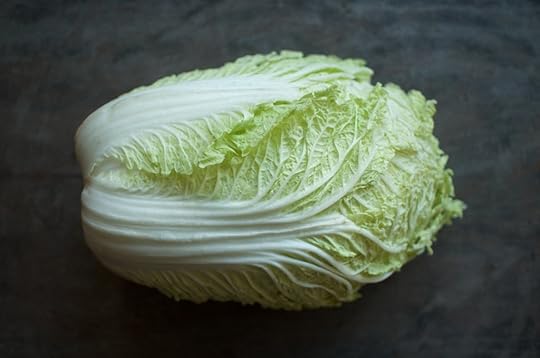
Hello Mastery Challenge participants. From all the posts on the Food in Jars Community Group and the #fijchallenge hashtag on Instagram, lots of you are excitedly participating in this month’s challenge topic. I’ve seen so many batches of sauerkraut, kimchi, sourdough, ginger bug, kombucha, and more.
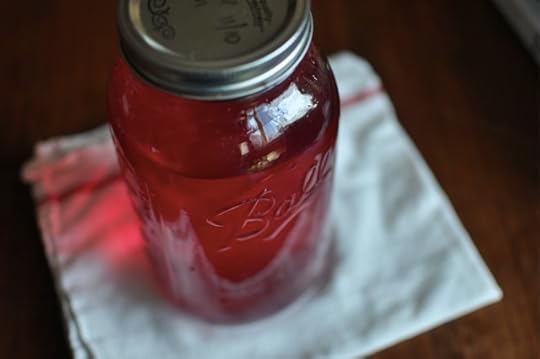
Remember that you don’t have to share your post on social media to participate in the challenge. The option to share on a blog, on Instagram, or in our FB community group is simply there as a way to help you connect with other challenge participants and build your virtual and real life food preservation communities.
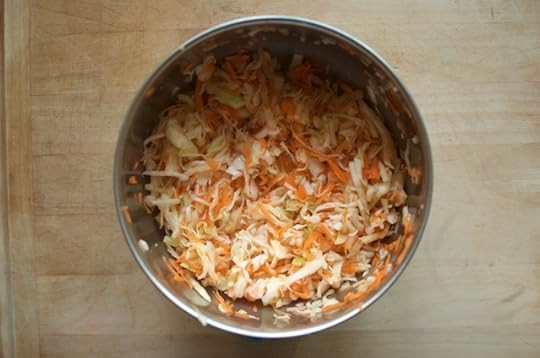
If you prefer to work alone, that’s okay too. Just use the form below to submit your project and skip the field that asks for a link.
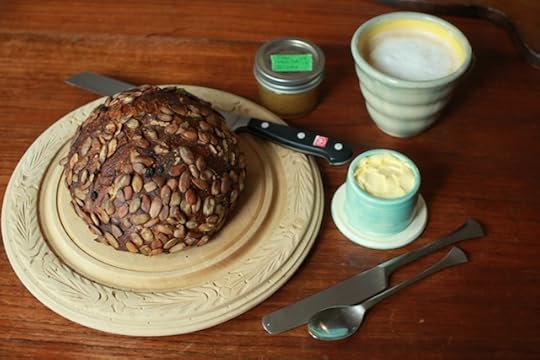
The deadline for submission is February 25, but if you’re already done, feel free to submit them now. I do ask that you only submit the form once, so that I can get an accurate count of the number of people participating this month. If you don’t see the form below, click this link to find it.
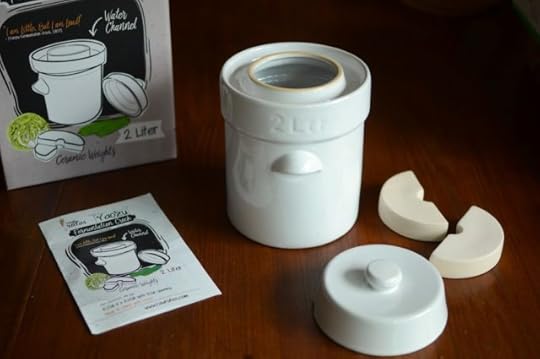
Related Posts:Fermentation for the February Mastery ChallengeFood in Jars Facebook Live ReturnsFermentation for the November Mastery Challenge
February 6, 2019
Kimchi Kraut Recipe
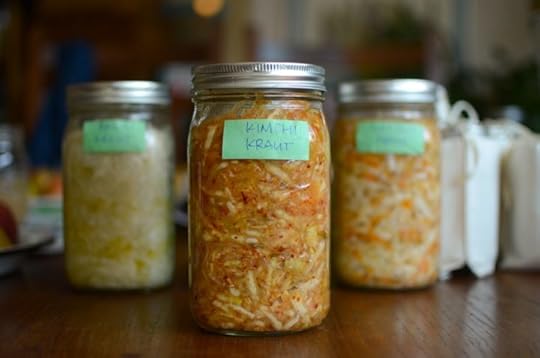
A couple years ago, I had a freelance project in which I made three sauerkraut variations. I loved the recipe development process and the fact that I had multiple jars of delicious kraut in my fridge when I was done. However, the piece got killed and the recipes and photos never saw the light of day.
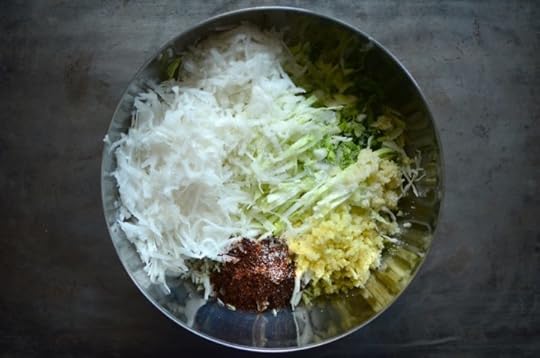
I knew that the time would eventually come around for these recipes and the time is now! I’m going to share these tasty variations over the course of the next several weeks. I hope you like them!
PrintKimchi Kraut Recipe
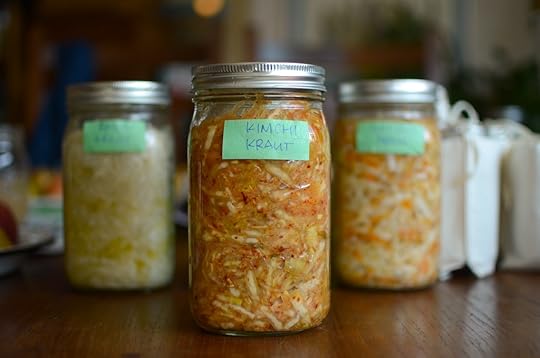
Ingredients
1 1/2 pounds cabbage, thinly sliced8 ounces daikon, grated
4 scallions, sliced
4 garlic cloves, minced or pressed
3 tablespoons finely chopped fresh ginger (about 1 ounce)
2-3 tablespoons gochugaru (use more or less based on how spicy you want your finished kraut to be)
1 tablespoon pickling salt
1 teaspoon granulated sugar
Instructions
Place cut cabbage, daikon, scallions, garlic, ginger, gochugaru, and salt in large bowl.Using your hands (if your skin is sensitive, wear food safe gloves), knead the ingredients together, squeezing firmly to help release liquid from the veg.
When the volume in the bowl appears to have reduced by half, pack the massaged veg into a wide mouth quart jar in layers, firmly pressing it down each time before adding more (the entire batch should fit into a single quart jar).
Press cabbage down firmly in the jar, so that liquid bubbles up over the surface of the jar. Loosely cap the jar (or top with an airlock, if you have one), position it on a small saucer or plate, and place it in a cool, dark spot.
Check every other day, removing any bloom and pressing cabbage down if it has floated above the liquid (be warned, it will be a bit stinky. That’s normal).
After a week, taste the sauerkraut. If you like the flavor, place the jar in the refrigerator. If you want something a bit stronger, let it continue to ferment until it pleases you.3.1https://foodinjars.com/recipe/kimchi-kraut-recipe/
Related Posts:
Fermentation for the February Mastery Challenge
Mastery Challenge February Round-up: Salt Preserving
Food in Jars Facebook Live Returns
February 3, 2019
Food in Jars Facebook Live Returns
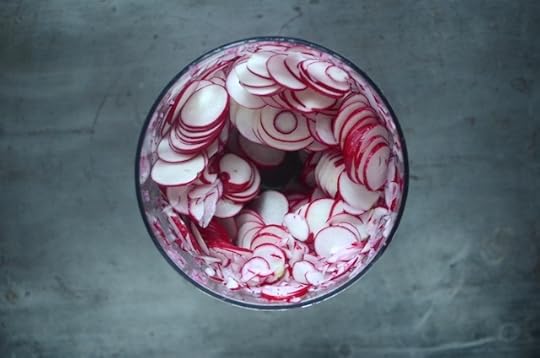
My bi-monthly Facebook Live demos have been on a break for the last two months (blame the holidays and the relentless cold I had for all of January), but they’re coming back!
I will be showing you how to make a quick and easy batch of fermented radish slices (since fermentation is our Mastery Challenge topic for February) on Monday, February 4, 2019 at 9 pm ET/6 pm PT over on the Food in Jars Facebook page.
This demo (like all of these livestream events I do) are your opportunity to hang out with me in my kitchen, ask questions, and hopefully build your personal toolbox of food preservation skills. I hope to see some of you there!
Related Posts:Fermentation for the February Mastery ChallengeFermentation for the November Mastery ChallengeFacebook Live Shrub Demo This Thursday
February 1, 2019
February Partners: Fillmore Container, EcoJarz, McDonald Paper, and Mason Jar Lifestyle

Happy February, dear readers! It’s the start of the month and that means that it’s time to thank the businesses that help make this site possible. Please do show them that you appreciate their support with your time and attention!
Lancaster, PA-based and family-owned Fillmore Container are first! They offer all manner of canning jars, lids, and other preservation gear and carry just about every Ball jar currently available , so if you’re looking for a particular style, check them out. Their blog is also a great resource, so keep it on your must-check list!
Our friends over at EcoJarz are another stalwart sponsor. They make an array of products designed to fit on top of mason jars, including cheese graters, coffee brewers, and stainless steel storage lids.
Back for another month is McDonald Paper & Restaurant Supply. Based in Brooklyn, they are open to the public and sell all manner of culinary supplies. Restaurant supply stores are a great way to get affordable, durable kitchen gear (including jars!). I’m a big of their big food storage containers for macerating fruit for jam and or stashing loads of soup. Dig into all their kitchen gear here.
Mason Jar Lifestyle isa one-stop shopping site for all the jar lovers out there. They sell all manner of mason jar accessories and adaptors. If you’re in the market for lids, straws, sprouting lids, fermentation weights, airlocks, tea light converters, cozies, they are there for you. I recently featured their Leak Proof Plastic Storage Lids (I reach for them all the time in my kitchen!).
And if your company, shop, or family business is interested in reaching the food-loving and engaged Food in Jars audience, you can find more details here. Leave a comment on this post or drop me a note to learn more!
Related Posts:December Partners: Fillmore Container, EcoJarz, McDonald Paper, and Mason Jar LifestyleNovember Partners: Fillmore Container, EcoJarz, McDonald Paper, and Mason Jar LifestyleOctober Partners: Fillmore Container, EcoJarz, McDonald Paper, and Mason Jar Lifestyle




